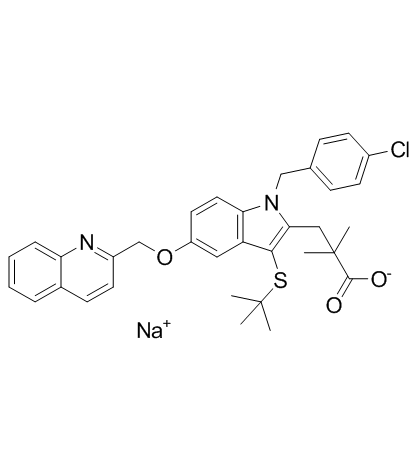Quiflapon sodium |
| Catalog No.GC37059 |
Quiflapon sodium (MK-591 sodium) is a selective and specific 5-Lipoxygenase-activating protein (FLAP) inhibitor.
Products are for research use only. Not for human use. We do not sell to patients.

Cas No.: 147030-01-1
Sample solution is provided at 25 µL, 10mM.
Quiflapon sodium (MK591) is a selective and specific 5-Lipoxygenase-activating protein (FLAP) inhibitor.
Quiflapon sodium (MK591) and SB203580 are able to block SEB-induced human PBMC cell proliferation. Quiflapon sodium (MK591) down regulates three genes [for cathepsin L, IL-17 and guanylate binding protein (GBP)-2] that are up regulated by SEB[1]. Quiflapon sodium (MK591) undergoes apoptosis within hours of treatment. Quiflapon sodium (MK591) also induces rapid activation of the stress kinase, c-Jun N-terminal kinase (JNK), which plays an important role in the apoptosis process. Quiflapon sodium (MK591) triggers apoptosis in prostate cancer cells without inhibition of PI3K-Akt, or ERK. Moreover, MK591 and LY294002 (an inhibitor of PI3K) exert synergistic effect in inducing apoptosis in prostate cancer cells[2]. Quiflapon sodium (MK591) influences cAMP response element-binding protein but not Sp1[4].
Hyperoxia groups of mice treated with Quiflapon sodium (MK591) (20, 40 mg/kg) show alveolarization that resembles that of room air controls while untreated hyperoxia groups show definite evidence of aberrant alveolarization but no inflammation[3]. Comparison of the Aβ-immunopositive areas between the placebo and Quiflapon sodium (MK591) (320 mg/kg)-treated group reveals a statistically significant reduction of the amyloid burden in the treated mice. Quiflapon sodium (MK591) also has a significant reduction in brain levels of IL-1β. Mice treated with Quiflapon sodium (MK591) show a statistically significant decrease in the steady-state levels of total CREB and its phosphorylated form at Ser133[4].
[1]. Mendis C, et al. Effect of 5-lipoxygenase inhibitor MK591 on early molecular and signaling events induced by staphylococcal enterotoxin B in human peripheral blood mononuclear cells. FEBS J. 2008 Jun;275(12):3088-98. [2]. Sarveswaran S, et al. MK591, a leukotriene biosynthesis inhibitor, induces apoptosis in prostate cancer cells: synergistic action with LY294002, an inhibitor of phosphatidylinositol 3'-kinase. Cancer Lett. 2010 May 28;291(2):167-76. [3]. Park MS, et al. 5-Lipoxygenase-activating protein (FLAP) inhibitor MK-0591 prevents aberrant alveolarization in newborn mice exposed to 85% oxygen in a dose- and time-dependent manner. Lung. 2011 Feb;189(1):43-50. [4]. Chu J, et al. Involvement of 5-lipoxygenase activating protein in the amyloidotic phenotype of an Alzheimer's disease mouse model. J Neuroinflammation. 2012 Jun 14;9:127.
Average Rating: 5 (Based on Reviews and 19 reference(s) in Google Scholar.)
GLPBIO products are for RESEARCH USE ONLY. Please make sure your review or question is research based.
Required fields are marked with *




















